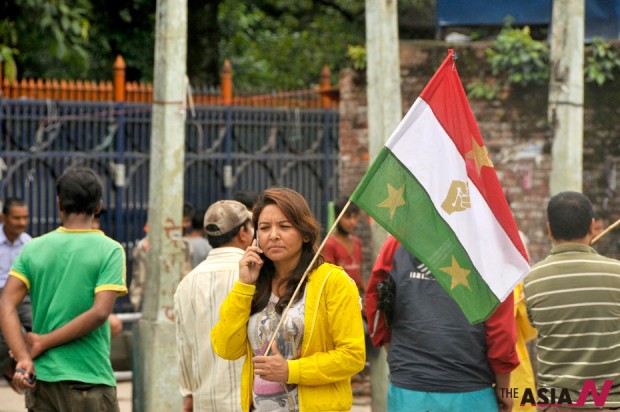Dissent follows Nepal’s election date announcement

A protester holds a party flag during a general strike in Kathmandu, Nepal, June 16, 2013. The Nepalese government has decided to hold the new Constituent Assembly (CA) election in Nov. 19 this year for drafting a new constitution while 42 political parties called a strike to protest the government's decision. (Photo : Xinhua/Sunil Pradhan)
Kathmandu – Almost three months after its formation, the election interim government of Nepal has decided to hold the Constituent Assembly (CA) election on November 19. The announcement of the poll date has ended the uncertainty about the second CA elections in this tiny Himalayan country. The key parties have already intensified their election activities.
However, four days after the announcement of the poll dates, a few dissenting parties led by a break-away faction of the Maoist party that had waged an armed insurgency for a decade from 1996 to 2006 causing deaths of about 15,000 people in this otherwise peaceful country, challenged the government’s move to hold the elections by calling a nationwide general strike on Sunday. Life came to a grinding halt through the strike called by the anti-government and anti-election parties.
The hardliner Maoist leaders and a few leaders of regional parties active in the southern part of the country have strongly been opposing the election as well as the sitting government led by Chief Justice Khil Raj Regmi.
Regmi was appointed to the top executive post at the initiative of chairman of Maoist party Pushpa Kamal Dahal ‘Prachanda’ and in the backing of the international power centres including India, US and the European Union. But Prachanda’s former colleagues have termed the government as a puppet of India and are using their full strength to disturb the polls to be conducted by it.
The general strike of Sunday was a rehearsal of their move towards thwarting the polls, said political pundits.
However, four key political parties—Unified Communist Party of Nepal-Maoist (UCPN-Maoist) led by Prachanda; Nepali Congress (NC), the oldest and largest democratic party of Nepal; CPN-UML, a liberal communist party; and United Democratic Madhesi Front, an alliance of pro-Indian regional parties of southern Nepal, have been confident about holding the proposed polls. They are the constituents of the High Level Political Committee formed to guide and instruct the election government.
These parties agreed to form the election government under Chief Justice Regmi after two rival parties—Nepali Congress and UCPN-Maoist were not ready to accept leadership of each other in the government. Due to a growing row between the democratic forces led by NC and radical communists led by UCPN-Maoist and the India-loyal regional parties, Dr. Baburam Bhattarai of the Maoist party stepped down three months ago, paving a way to form an election government. Dr. Bhattarai was widely portrayed as an India loyal leader by his own party comrades and the political analysts of Nepal.
Of course, Nepal’s political parties, which came together after the royal takeover of 2005, were sharply divided after the 2008 assembly elections, which had culminated in overthrowing the 240-year old institution of monarchy.
In the 2008 elections, the UCPN-Maoist had emerged as the largest party by electing 240 members in the 601-member first-ever CA of Nepal. However, the traditional parliamentary forces led by NC could not digest the surprise win of the former rebels in the elections while the Maoists undermined the strength of the traditional forces too much and committed one blunder after another resulting in the fall of their government led by Prachanda in 2009. The rivalry finally led to communal division among the Nepalese and caused the dissolution of the CA in May 2012. In his desperate bid to return to and retain power, Prachanda encouraged the leaders representing different ethnic groups to fight for their rights, which resulted in deserting two democratic parties—NC and UML by a significant number of ethnic leaders and formation of ethnic-based parties. The CA was dissolved when Prachanda and other leaders failed to manage the demands of the ethnic groups in which each of them should have separate provinces. And, it took more than a year for the political parties to agree on holding the polls.
However, the parties had to authorize the government to decide on the election law when they failed to sort out the differences, especially regarding the provision of threshold (only those parties garnering 1 per cent of total cast votes would have their representatives in the CA) and preventing leaders convicted of crimes from contesting in the elections. The government announced the dates scarping both these provisions.
But, observing the developments of the first three days after the announcement of the polls, one cannot be sure whether the polls will be possible on the scheduled dates.























































































